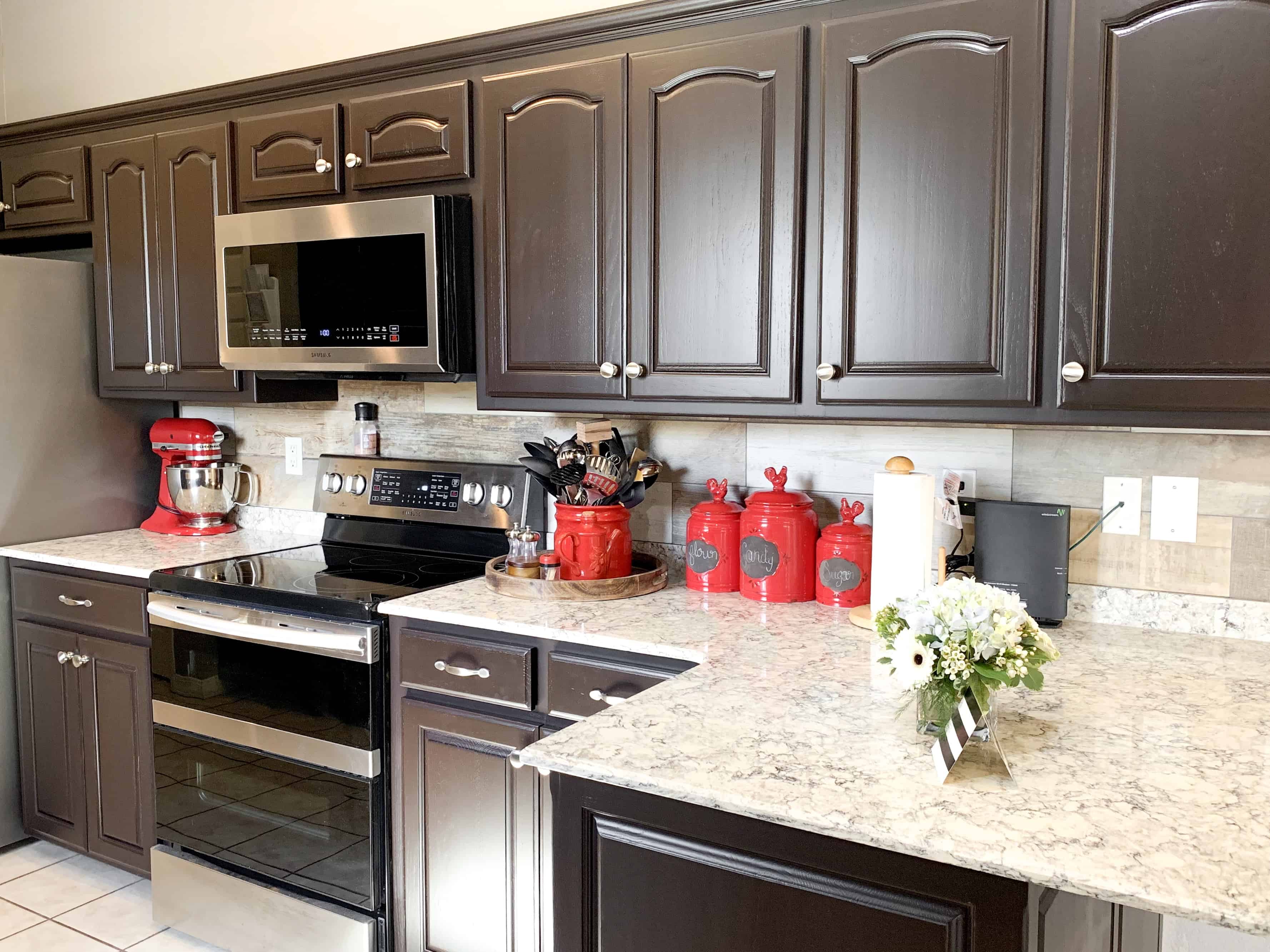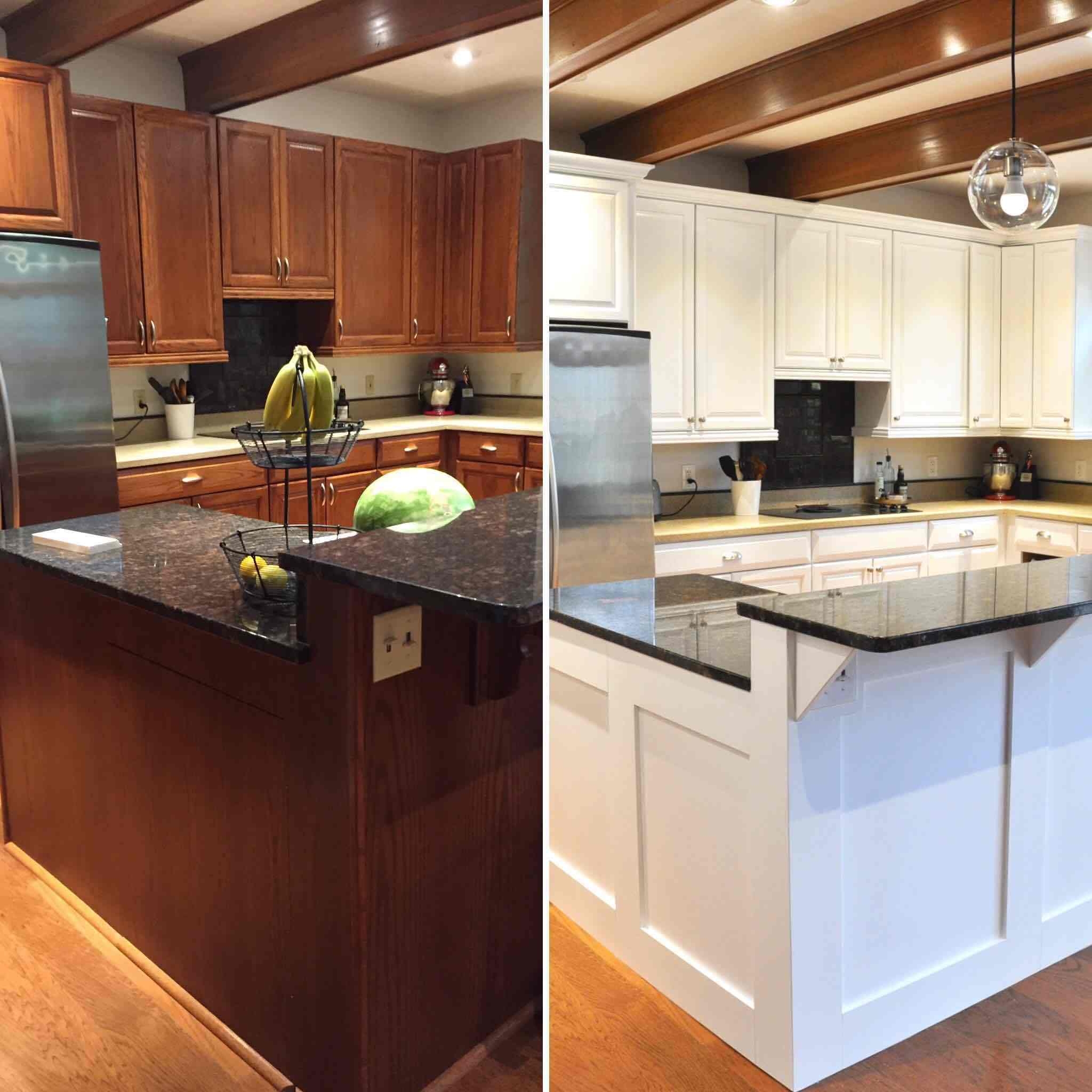Preparation and Surface Cleaning

Proper preparation is paramount to achieving a high-quality, durable paint finish on oak cabinets. Neglecting this crucial step can lead to peeling, chipping, and an overall unsatisfactory result. Thorough cleaning and sanding are essential to ensure the paint adheres properly and provides a smooth, even surface.
How to paint oak cabinets white – Surface preparation involves a multi-step process designed to create an optimal substrate for paint adhesion. This process begins with a thorough cleaning to remove grease, grime, and any previous finishes. Subsequently, sanding is employed to smooth the surface, creating better mechanical bonding between the wood and the paint. The level of sanding required depends on the existing finish.
Oak Cabinet Surface Preparation Steps, How to paint oak cabinets white
The following steps detail the preparation process for painting oak cabinets, accommodating variations in existing finishes.
- Remove Hardware: Disassemble the cabinet doors and drawers, removing all knobs, handles, and hinges. This allows for thorough cleaning and sanding of all surfaces. Carefully label each piece for easy reassembly.
- Clean the Surfaces: Use a suitable cleaning solution (see table below) to remove grease, dirt, and any residue. Apply the solution with a soft cloth or sponge, rinsing thoroughly with clean water and allowing the cabinets to dry completely.
- Sanding (Existing Finish): The sanding process will vary depending on the type of existing finish.
- No Finish/Bare Wood: Light sanding with 120-grit sandpaper may be sufficient to raise the grain and create a slightly rough surface for better paint adhesion.
- Wax or Oil Finish: Thorough sanding is required to remove the existing finish. Start with 120-grit sandpaper, progressing to finer grits (180-220) for a smoother surface. Multiple passes may be necessary. A power sander can expedite this process, but caution must be exercised to avoid gouging the wood.
- Lacquer or Varnish Finish: These finishes are more durable and require more aggressive sanding. Start with 80-grit sandpaper, then progress to 120-grit, 180-grit, and finally 220-grit. Use a dust mask to prevent inhalation of sanding dust.
- Fill Imperfections: After sanding, inspect the cabinets for any imperfections such as dents or scratches. Use wood filler to repair these, allowing it to dry completely before sanding smooth.
- Clean Again: After sanding and filling, thoroughly clean the cabinets again with a tack cloth to remove all dust particles. This is critical for optimal paint adhesion.
Cleaning Solutions for Oak Cabinets
The choice of cleaning solution depends on the type and level of soiling. Consider the pros and cons of each option before selecting the most appropriate one for your cabinets.
| Cleaning Solution | Pros | Cons | Application Method |
|---|---|---|---|
| Mild Dish Soap and Water | Gentle, readily available, inexpensive | May not effectively remove stubborn grease or grime | Mix a small amount of dish soap in warm water. Apply with a soft sponge or cloth, rinse thoroughly, and dry completely. |
| TSP (Trisodium Phosphate) | Effective at removing grease and grime, degreases well | Can be harsh on skin and eyes; requires thorough rinsing; not suitable for all surfaces | Follow manufacturer’s instructions carefully. Wear gloves and eye protection. Rinse thoroughly and allow to dry completely. |
| Degreaser (e.g., Krud Kutter) | Excellent for removing stubborn grease and grime | Strong chemicals; requires thorough ventilation; may damage some finishes | Apply according to manufacturer’s instructions. Wear gloves and eye protection. Ensure adequate ventilation. Rinse thoroughly and allow to dry completely. |
| Tack Cloth | Effectively removes dust and loose particles after sanding | Not suitable for removing grease or grime; only for final dust removal | Wipe the surface gently with a tack cloth, replacing frequently as it becomes dirty. |
Importance of Proper Surface Preparation
Proper surface preparation is crucial for achieving a durable and aesthetically pleasing paint finish. A clean, smooth surface ensures optimal paint adhesion, preventing peeling and chipping. Thorough sanding creates a mechanical bond between the paint and the wood, enhancing the longevity of the paint job. Skipping or inadequately performing these steps can result in a poor finish that requires costly rework or even refinishing.
For instance, if grease or grime remains on the surface, the paint will not adhere properly, leading to peeling or chipping. Similarly, if the surface is not sanded sufficiently, the paint may not adhere evenly, resulting in an uneven texture and appearance. In both cases, the final result would be unsatisfactory, necessitating further effort and expense to rectify.
Priming and Painting Techniques: How To Paint Oak Cabinets White
Priming oak cabinets is a crucial step before painting, ensuring optimal paint adhesion and a professional finish. The choice of primer depends on several factors, including the existing finish on the cabinets and the desired final look. Proper priming prevents the wood grain from showing through the paint and provides a uniform surface for even color distribution. Selecting the right primer and applying it correctly significantly impacts the longevity and appearance of the painted cabinets.
Primer Selection and Application Methods
The selection of a primer is critical for achieving a successful paint job on oak cabinets. Three common priming methods are detailed below, each with its advantages and disadvantages.
- Oil-Based Primer: Oil-based primers offer excellent adhesion, especially to glossy surfaces, and provide a durable base for the topcoat. They tend to penetrate deeply into the wood, sealing it effectively. However, oil-based primers have a strong odor, require longer drying times, and necessitate the use of mineral spirits for cleanup. This method is ideal for cabinets with a previously glossy finish or those needing superior stain blocking.
- Sheen-Based Primer: Sheen-based primers, often acrylic-based, offer a balance between the advantages of oil-based and water-based primers. They provide good adhesion, are relatively easy to clean up with soap and water, and have less odor than oil-based options. While not as penetrating as oil-based primers, they still offer adequate sealing for most oak cabinet applications. They are a good middle ground option for many projects.
- Water-Based Primer: Water-based primers are low-odor, easy to clean up with soap and water, and dry quickly. They are environmentally friendly and a popular choice for many DIY projects. However, they may not offer the same level of adhesion or stain-blocking power as oil-based primers, particularly on glossy surfaces. A second coat may be necessary for optimal results, especially on highly porous wood.
Paint Application Techniques
Applying paint to oak cabinets requires precision and attention to detail to achieve a smooth, professional finish. Three common methods—brush, roller, and sprayer—each have distinct advantages and disadvantages.
| Method | Advantages | Disadvantages | Best Practices |
|---|---|---|---|
| Brush | Provides excellent control and detail work, ideal for corners and edges. | Can be time-consuming and prone to brush strokes if not applied correctly. Requires more effort to achieve a smooth finish. | Use a high-quality angled brush, apply thin, even coats, and use smooth, overlapping strokes. Allow sufficient drying time between coats. |
| Roller | Covers large areas quickly and efficiently. | May leave roller marks if not used properly. Less control than a brush for intricate details. | Use a high-quality roller cover with a nap appropriate for the paint type. Apply even pressure and use a “W” pattern to minimize roller marks. |
| Sprayer | Provides a smooth, even finish quickly. Ideal for large surface areas. | Requires specialized equipment and can be messy if not used correctly. May require more cleanup. | Use a high-quality sprayer with adjustable settings. Maintain a consistent distance from the surface and apply thin, even coats. Proper ventilation is crucial. |
Achieving Even Paint Coverage
Achieving even paint coverage and avoiding brush strokes or roller marks requires careful technique and the right tools. Thin coats are crucial; multiple thin coats are always preferable to one thick coat. For brushes, use smooth, overlapping strokes in the same direction, avoiding back-and-forth motion. For rollers, use a “W” pattern to distribute paint evenly and minimize lap marks. Allow adequate drying time between coats to prevent lifting or unevenness. Light sanding between coats with fine-grit sandpaper can help smooth out imperfections and improve adhesion. The final coat should be applied carefully to ensure a uniform and flawless finish.
Advanced Techniques and Troubleshooting

Painting oak cabinets white is a rewarding project, but even experienced DIYers can encounter challenges. This section addresses common problems and provides solutions to help you achieve a professional-looking finish. Understanding these advanced techniques will ensure a smoother process and a stunning final result.
Addressing Common Painting Problems
Several issues can arise during the painting process. Careful preparation and the right techniques are crucial for preventing these problems. Addressing them promptly can save time and effort in the long run.
- Drips and Runs: Drips and runs are often caused by applying paint too thickly or using a brush with too much paint. To prevent this, load your brush or roller with less paint, and use long, even strokes. If drips or runs do occur, allow the paint to dry completely before lightly sanding the area smooth and reapplying a thin coat. The key is to work in thin, even layers rather than trying to achieve full coverage in one go.
- Uneven Coverage: Uneven coverage can result from inadequate surface preparation or using the wrong paint type. Ensure the surface is properly primed and sanded smooth before painting. Applying multiple thin coats, rather than one thick coat, will lead to a more even finish. If you’re still seeing unevenness after multiple coats, consider using a higher-quality paint with better hiding power. Using a paint sprayer can also provide a more consistent finish.
- Brush Strokes: Visible brush strokes are a common problem, especially with high-gloss paints. To minimize brush strokes, use a high-quality brush designed for smooth application. Apply the paint in long, even strokes, working in the same direction. Consider using a roller for larger surfaces to achieve a more uniform finish. Light sanding between coats can also help to smooth out any imperfections.
Applying Multiple Coats of Paint
Multiple coats are essential for achieving a durable and visually appealing finish. The number of coats needed depends on the paint type, the color, and the desired level of opacity.
The drying time between coats is crucial. Most paints require at least four to six hours of drying time before applying the next coat. However, it’s always best to refer to the manufacturer’s instructions on the paint can, as drying times can vary depending on the paint type, temperature, and humidity.
Light sanding between coats is recommended to smooth out any imperfections and to ensure proper adhesion of subsequent coats. Use fine-grit sandpaper (220-grit or higher) and sand gently in the direction of the wood grain. Always remove sanding dust with a tack cloth before applying the next coat. This meticulous approach contributes to a flawless, professional-looking finish. For instance, if you are painting a dark oak cabinet white, several thin coats are essential to achieve full coverage and prevent the dark wood from showing through.
